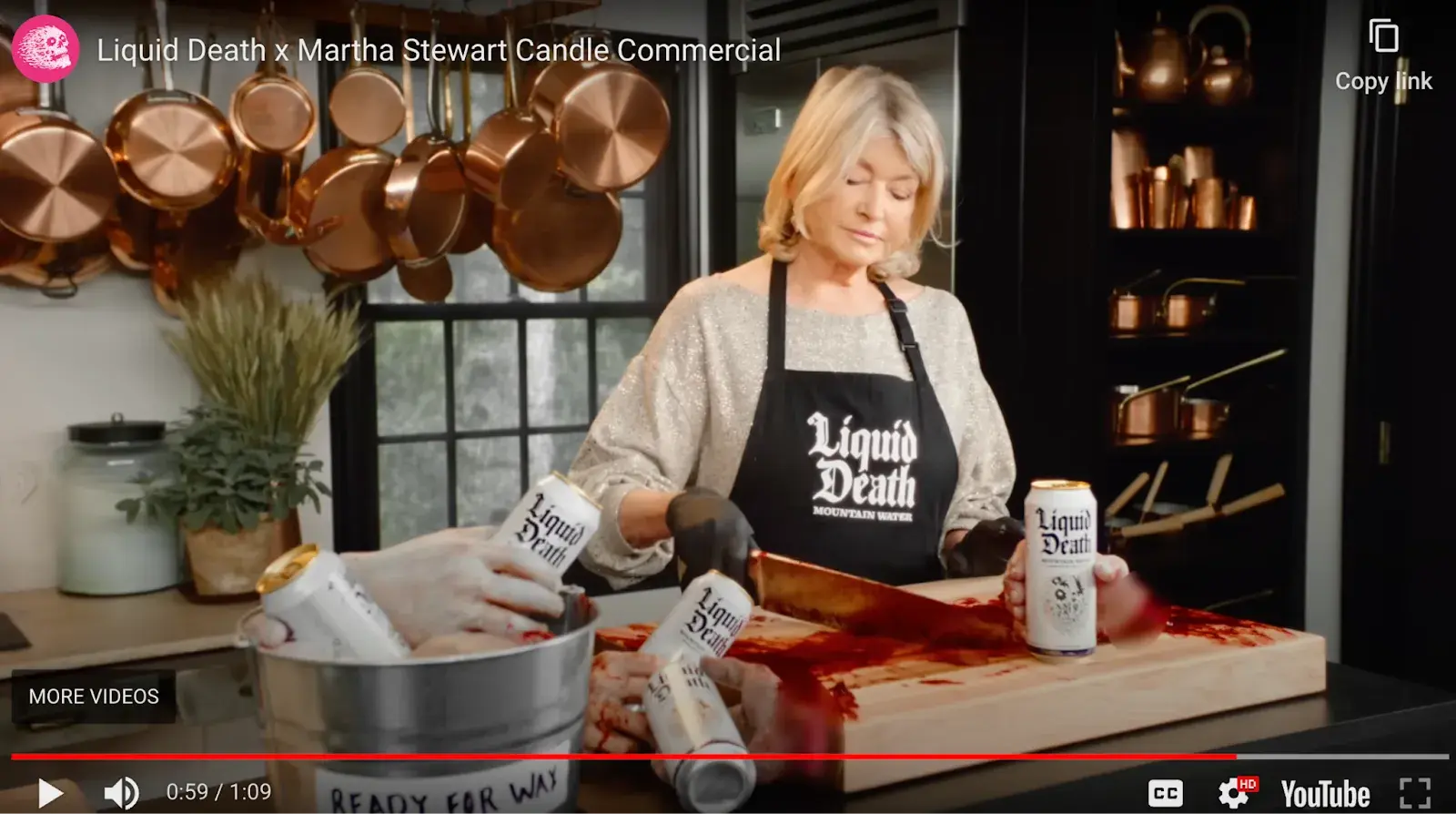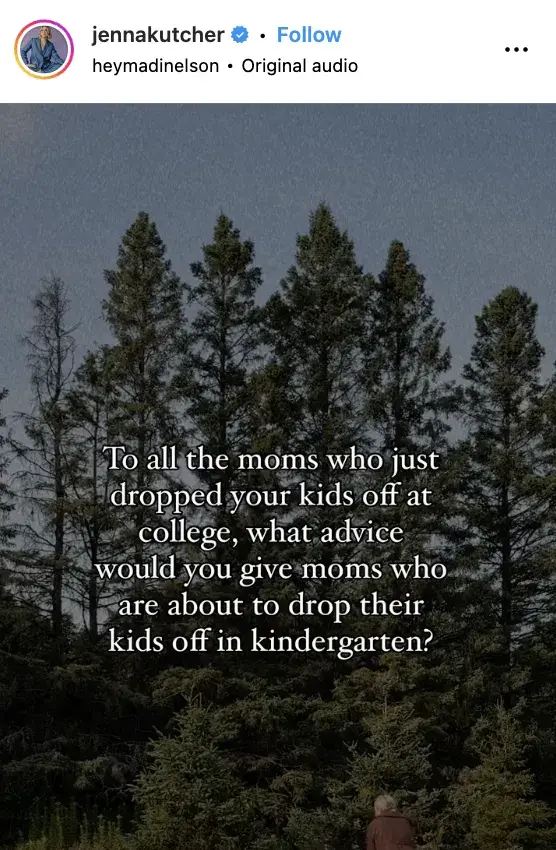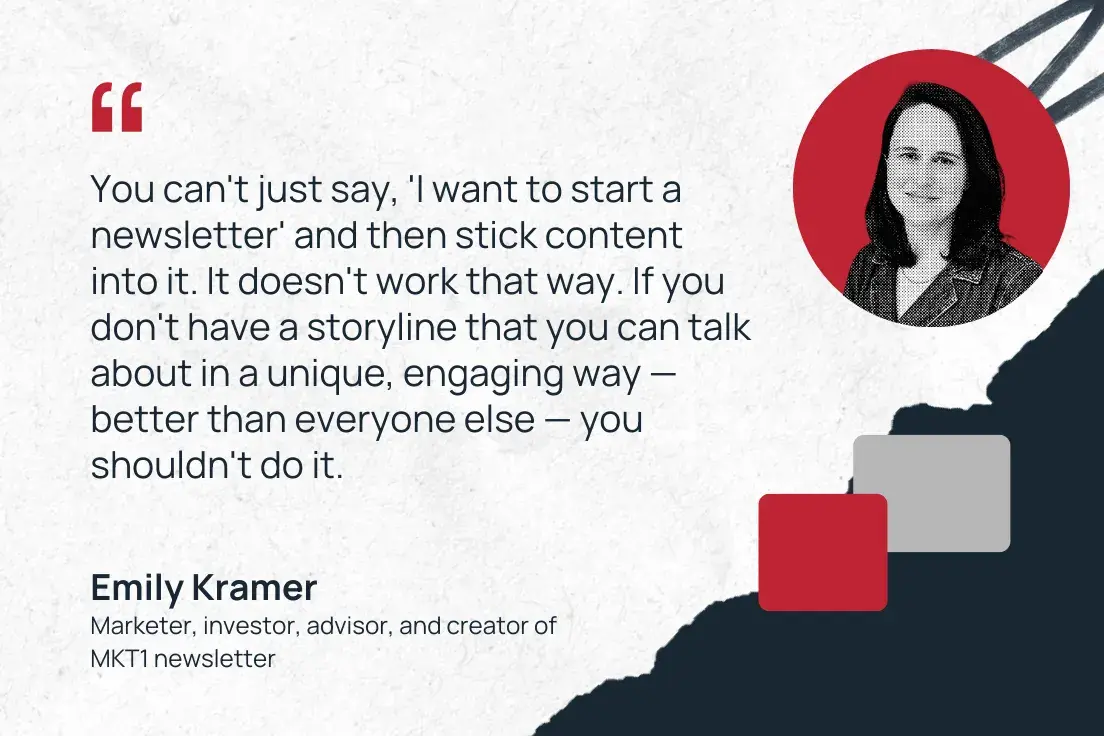Each week, Laura, Caroline, and I get to sit and chat with some of today’s most innovative marketing masters. We’ve run down the rabbit hole with folks from Spotify, Liquid Death, Oatly, New Balance, Zapier, Hootsuite, the Brooklyn Nets, and even the makers of Chicago’s most beloved tirefire-flavored liquor.
If you could smoosh all of their combined wisdom into your head, it would be like getting your… well… master’s in marketing. (Oh, hey. I just got the name.)
Well, you can’t. Not until brain chips are a thing.
Until then, you can do the next best thing: Check out 12 of the most insightful, provocative, or just downright useful lessons our experts had to share.
Lesson 1: People aren’t brainless consumers.
Here‘s a fun fact: At Liquid Death, they don’t use the word consumer. Ever.
Instead, they have a team called “human insights.”
Greg Fass, Liquid Death’s VP of marketing, is proud to work against the mindset that people are just “brainless consumers” whose sole purpose on Earth is to consume products. (Yep – that’s a direct quote.)
Instead, he says, “At Liquid Death, I‘m proud that we think of our audiences as people. And when you think of them as humans, you understand they’ll get a piece of copy that isn‘t straightforward, or jokes other brands are afraid to make. They’re intelligent, and have a sense of humor.”
It’s a philosophy that has served them well. Just consider the commercial where Martha Stewart is a serial killer chopping off hands to make candles — not exactly something that would go over well in a standard marketing pitch.

Liquid Death has done more than reinvent the better-for-you beverage category — they’ve reinvented marketing, as well.
Embracing their anti-marketing approach can help you discover fresh and novel ways of connecting better with, well, other humans.
Lesson 2: “If you’re not risking your career on a bold marketing move, you’re not thinking big enough.”
Ron Goldenberg, VP of international marketing & innovation at BSE Global, got plenty of pushback when he pitched a Brooklyn Nets activation — in Paris, complete with an orchestral tribute to The Notorious B.I.G. and Brooklyn Nets-inspired pizzeria.
One colleague even said to him, “You really think Parisians are going to show up to a Brooklyn Nets pizzeria?” (I get the hesitation — don’t they live off of escargot and croissants?)
He knew there could be major ramifications if the event flopped. But he believed in the concept enough to risk it all.
“If I‘m going to get fired for anything, it’s worth [it] for an orchestral tribute to Biggie in Paris,” Goldenberg told me last week. “When your ideas are big enough and bold enough, and you believe in them to the degree that you‘re willing to take a reputational risk, that’s when you’re onto something.”
Playing it safe can be a risk in itself. But marketing thrives on standing out, which demands taking chances.
For Goldenberg, the payoff was massive:
- Fans snapped up all 15K tickets to the Nets-Cavaliers game, 3.3K visitors indulged in Brooklyn pizza, and Biggie’s tribute sold out in five days 🍕
- 450K unique visitors to Brooklynets.com/paris
- 64K emails captured (90% net-new to their database)
- 195% YoY surge in ticket sales to French consumers and over seven figures in total revenue 💵

Goldenberg got stakeholders on board by being blunt: “You all need to understand how important this is, not just for the Nets but for our fans and the global sports industry,” he told colleagues. “It’s never been done before at this scale.”
Sticking to the tried-and-true is tempting. But it was insight matched with instinct that landed Goldenberg his big swings.
Read How An NBA Marketer Brought the Brooklyn Nets to Paris (& What Marketers Can Learn from Him)
Lesson 3: Break the fourth wall.
The first Malört ad I ever saw was in 2022, in season one of the Chicago-set TV show The Bear, of all places. Anna Sokratov says it was one of the first ads they ever ran — for nearly a century prior, Malört relied on word of mouth and Chicagoans pranking out-of-town guests.
Since marketing Malört is such a new phenomenon, Sokratov, brand manager for Jeppson’s Malört, feels a lot of freedom to be funny, to be outlandish, to be experimental. (In fact, one of the people she looks to for inspiration is previous marketing master Greg Fass of Liquid Death.)
It’s an old saw at this point that authenticity drives consumer loyalty. But less is said about what authenticity looks like. “People are really looking for brands that break that fourth wall,” Sokratov says. “They want to see the people behind the brand.”
Past and present employees appear in a series of ads featuring Malört faces (Google it), which are underscored by the tagline, “Do not enjoy. Responsibly.” Malört may be a lot of things, but it’s neither dishonest nor indirect.
Read “This is disgusting, try some”: Marketing Chicago’s vile-tasting liqueur
Lesson 4: Use the peanut butter method.
“Everyone hates advertising, but they’re okay being sold to,” Hassan S. Ali, creative director of brand at Hootsuite, says.
It’s like using peanut butter to sneak your dog a pill. “If people are willing to be sold to, pitch the pill in something yummy. People will watch it.” (Let’s ignore for a moment that we are all the hapless dogs in this analogy.)
“I often think that the best ads are ones we can‘t measure, because they’re shared in a group chat with friends.” I sincerely hope nobody is working on a pixel that can track my group chats, but it’s true that if somebody shares an ad, it’s because it’s both funny and emotionally resonant.
Maybe you see a funny ad for diapers. Your sister’s just had a baby, and you share the ad in the family group chat. “All of a sudden, there’s a bond formed through this piece of advertising.” And it goes beyond “here, buy this thing,” Ali says.
Without that (hopefully imaginary) group-chat tracking pixel, traditional marketing metrics won’t necessarily be of much use.
“But what did you solve for the customer?” Ali asks. “Those are the real results.” The more we can focus on that, “the better we’ll be as marketers.”
Lesson 5: Don’t let growth marketing dominate your strategy
A favorite rant of Brendan Lewis (EVP of global communications and public affairs for Oatly) is his belief that growth marketing needs to be “neutered, if not totally destroyed.”
“It‘s nothing more than spreadsheet marketing,” he tells me. When marketers are buying clicks and perfecting their emails for click-through rates, Lewis says they’re leaving out an essential ingredient: emotion.
“If you water down your message to optimize it for clicks, you lose your soul,” he tells me without a trace of grandiosity. “The emotion and the belief has to be there. It can’t just be somebody looking at email click-rates all day.”
(Got it – I‘ll stop obsessing about this email’s subject lines…)
For Oatly, this means taking the leap without testing it to death first. Like in 2023, when the company bought billboards in Times Square to proudly endorse its climate label. (The Oatly team invited the dairy industry to join them. They declined.)
The secret sauce? Oatly is a mission-led company that happens to sell oat milk; it’s not a product-led company in search of a mission. So its leaders are able to act on impulse and hunch as long as they know their messaging caters to their larger goal of promoting sustainability.

Read It’s Like Marketing, But Made for Humans: Lessons from Oatly’s EVP
Lesson 6: Less strategy, more heart.
I’ll admit, this lesson sounds suspiciously like a Friday Night Lights quote.
But it’s also a takeaway Jenna Kutcher, host of The Goal Digger podcast, is passionate about sharing.
“As creators, we need to get back into the creation of our content. We need to go back to what worked a decade ago and share our lives and what we love online,” she tells me.
“Too many business owners have created systems and teams and gotten too far away from the content, and their audiences feel that divide.”
Case in point: How likely are you to respond, “OMG CUTE” to an Instagram reel from Lululemon‘s branded handle? I’m guessing not likely.
But what about when a friend posts herself in new Lulu joggers?
In the age of AI, people are desperate to connect with real humans.
Impressively, this means Jenna is the only person who creates IG content for her 1M+ followers. She also responds to all her own DMs and comments.
Nobody on her team has access to her login because “that’s the heartbeat of my connection with my audience.”
Jenna’s advice here is simple, but not easy: “Take some of the strategy out, and put the heart back into it. Be off the cuff, and share things for the sake of sharing versus just looking for ways to monetize.”

Read Digital Marketer Jenna Kutcher Thinks You’re Overcomplicating It
Lesson 7: Your customer is the hero. Not you.
April Sunshine Hawkins, co-host of the Marketing Made Simple podcast, sees too many marketers position their brand as the heroes, and she says it’s one of the biggest mistakes marketers can make.
“Everybody wakes up the hero of their own story. Your customers, the people you’re trying to draw in… The story needs to be about them.”
In other words, you’re not Batman — you’re Alfred.
Take a recent example: Hawkins was working with a jewelry brand that creates products in Malawi and pays their workers 3-5X the minimum wage. Naturally, they wanted to shout that from the rooftops. Who wouldn’t?
But Hawkins stepped in and pointed out that the brand isn’t supposed to be the hero. The customer is.
“We rewrote the campaign to ask, ‘How can these pieces help people celebrate a milestone — like a promotion, an anniversary, a birthday?”
Suddenly, the jewelry wasn’t just jewelry; it became a badge of a customer’s big (and small) life moments.
Have you ever landed on a website and read the first few sentences and thought, Wow, is this person in my head? That’s the end-game: For your customers to feel like you get them.
“When we can position our products to align with what our customers are feeling, it creates that ‘ding, ding, ding’ moment — ‘That’s me! This is for me!’” Hawkins says. “That’s what we’re looking for.”
Read You’re Not The Hero — Your Customer Is
Lesson 8: Engage with the people who engage with you.
While you’re busy figuring out how to connect with your audience, don’t forget to actually connect with your audience.
“The number one thing you can do to maximize any budget you’re spending is to simply engage with the people who are engaging with you,” says Chandler Quintin, co-founder and CEO of Video Brothers.
And he’s not just talking about reactive engagement, like answering social messages or responding to emails. That stuff’s a given. He’s talking about proactive outreach to the people who interact with your business presence. Quintin himself sends a message to anyone who views his LinkedIn profile or watches a video he posts.
“We have booked almost 80% of our calls through simply engaging with people that engage with us versus them going to our website and filling out a form.”
And I’m a living testimonial to this tactic. Thursday morning, I’m sipping tea and cruising LinkedIn in search of marketing masters. (I do it for you! Well… not the tea. That’s for me.) Minutes later, Quintin messaged me asking for help because he was upside down. (See the hero image above.) Friday morning, we’re scheduling an interview.
Quintin acknowledges that this takes effort.
“It does take a lot of time. There might be some ways to automate it. But at the end of the day, I think people can kind of see through automations a little bit. Especially when you’re trying to make an authentic connection. The bar for that is: Just be authentic. Be a human being.”
But the return is worth the effort.
“If you only have $1,000, you’re going to be able to turn that $1,000 into the power of five or 10,000 if you just go that extra mile and engage.”
Read How an Entertainment Strategy Helps You Cut Through the White Noise
Lesson 9: Turn negative moments into a chance to show up.
Dawn Keller, CMO for California Pizza Kitchen, recounts a story:
Recently, a customer ordered mac and cheese from CPK — and just got cheese.
After she posted the vid on TikTok, CPK responded with a video in which Chef Paul jokingly walks through the steps of properly making a mac and cheese (emphasis on: Add the mac) and then announces 50% off mac and cheese for all CPK customers. (Since the customer only got 50% of her meal — get it?)
CPK’s TikTok response got 13.5 million views. Keller was shocked… and thrilled.
“It was mind-blowing to everybody [how well it did], but we believe what really made the difference was how we showed up — in a super authentic, humble, self-deprecating way. It wasn’t corporate-y or stuffy.”
CPK could‘ve chosen to ignore the customer’s complaint altogether, or they could‘ve commented on the video with a generic “I’m sorry!” customer service response. Instead, they decided to use the opportunity to reframe the narrative into something fun and lighthearted.
And as Keller points out, “We still got to reinforce what matters to us — which is that we have quality food, and we care about our guests. Authenticity and entertainment is what gets people’s attention… Not just that you’re using socials as an advertising channel.”
We’ve heard it across the board this year from Greg Fass, Jenna Kutcher, and plenty of other Masters in Marketing, and the point holds true: Being authentic and showcasing the human behind your brand is a much better strategy than a polished ad these days.
Read How California Pizza Kitchen Embraces Change, Goes Viral on TikTok, and Gives Consumers FOMO
Lesson 10: Be ready to tell leaders what you’ll stop, start, and continue.
Emily Kramer, founder of MKT1, has been the “first-ish” marketer four times at companies ranging from 10 to 300 employees, so my first question was an easy one: If you’re the first marketer at a company, where the heck should you start?
Kramer told me whether you’re a team of one or leading a 200-person marketing department, the answer is the same: Prioritize, prioritize, prioritize.
“First, you need to figure out where you can win. Where can you stand out? Where do you have the biggest advantage over competitors? What channels make the most sense for your business?”

This translates to: Stop doomscrolling through TikTok for “inspiration” or convincing yourself a snazzy newsletter giveaway will save the day. Start with what matters most.
“You‘ve got to have a framework for how you’re prioritizing — you have to put a stake in the ground about what you think is important, and why. If you don‘t, you’ll just get barraged with requests.”
One of Kramer’s go-to moves when joining a new company is to create a “start, stop, continue” plan. That way, execs can quickly see, “Oh, we already tried that,” or “We’re stopping this, and here’s why.”
Otherwise, your founder might just get a little too obsessed with the idea of you publishing ebooks on Amazon as the “next best marketing move.”
(Not speaking from experience or anything.)
Read How An Obsession With Quality Led Emily Kramer to 48k Newsletter Subscribers and Counting
Lesson 11: DIY — with curiosity.
“I always seem to have a side hustle these days,” says Maryam Banikarim, managing director of Fortune Media. (One gets the sense that Banikarim has always had to have a side hustle.)
It’s just that Banikarim’s side hustles would make most primary hustles envious. Last weekend, she celebrated the third year of The Longest Table, a community-building event born out of a need for human connection back when everyone was masking up and sharing tips on finding Lysol wipes.
She saw a neighbor put a folding table outside so they could eat dinner with a few friends. She introduced herself and thought, “What if I did that?”
One also gets the sense that Banikarim doesn’t do rhetorical questions. She started with a few posts on Next Door and an eight-person outdoor potluck on her street in Chelsea. On October 6, 2024, over a thousand people showed up for dinner.
Together they cobbled together a Squarespace website, and “we use HubSpot to email people.” (We did not bribe, pay, or threaten her to say that.—ed.) Banikarim doesn’t complain about DIY marketing tech; on the contrary, she refuses to be outpaced by evolving technology.
“Marketing has always been for people who are curious,” Banikarim says. And “in order to constantly be learning, it’s really helpful to be touching the tools yourself and not just directing from up high.”
Read One Question That Will Reinvigorate Your Approach to Marketing
Lesson 12: Marketing should make your buyer feel confident — not insecure.
Fashion is a notoriously confidence-crushing industry. Plenty of major fashion and beauty brands thrive off making their consumers feel less-than. They want you to know you’re not cool yet, but you will be when you wear those jeans or that jacket.
But Matt Zaremba, director of marketing for Bodega, calls that kind of marketing “empty calories and empty suits.”
“Sure, you‘ll find a cohort of people who you’ll grow with because you‘re showing them what they’re not. But eventually they‘ll find a brand that makes them feel like they are enough, and they’ll switch to that brand,” he says.
His MO? Being as humble and relatable as possible: “Fashion brands should offer tweaks to your journey of style and culture. I don‘t want to talk down to people and say, ’Oh, you don‘t know this musician?’ I‘d rather be like, ’You gotta check this out.’ There should be no ego in it.”
Whether you’re a B2C or B2B marketer, the sentiment stands — personifying your brand as the “cool kid” works for some brands, but what works better for most is simply being helpful, curious, and encouraging.
Read Bodega’s Matt Zaremba on How to Avoid Empty Calorie Marketing
Mastery in the Making
Feel that? That squeezy feeling is your brain getting bigger. Got room for a little bit more? Subscribe to Masters in Marketing and get fresh lessons in your own inbox each week.
![]()

